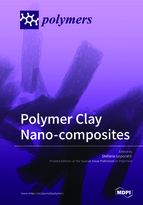Polymer Clay Nano-composites
A special issue of Polymers (ISSN 2073-4360). This special issue belongs to the section "Polymer Applications".
Deadline for manuscript submissions: closed (31 March 2019) | Viewed by 66243
Special Issue Editor
Interests: nanomedicine; drug delivery; scanning force microscopy; cytomechanics; nanocarriers
Special Issues, Collections and Topics in MDPI journals
Special Issue Information
Dear Colleagues,
This Special Issue focuses on the current state-of-the-art of “Polymer Clay Nano-Composites” for biomedical, anticorrosion, antibacterial, and other applications. Clay–polymer composite nanomaterials is an emerging area of research. Loading polymers with clay particles essentially enhances the composite strength features.
Of particular interests are different nano-assembly methods, such as silane mono and multilayers, polyelectrolyte layer-by-layer assembly, and others. An important development was reached for tubular and fibrous clay nanoparticles, such as halloysite, sepiolite, or imogolite. Polymer clay nanoparticles can be prepared as sheets in 1-nm thicknesses and a-few-hundred-nm wide (like kaolin, and montmorillonite). Fibrous clays reinforce significantly the nano-composites in the assembly with biopolymers and other green polymers leading to functional hybrid bio nano-composites.
Papers are sought that summarize selected areas (reviews) or discuss the latest research in the field (original articles). The scope of the Special Issue comprehensively includes the synthesis and characterization of polymer clay nano-composites used for several applications, including nano-clay polymer composites and hybrid nano-assemblies.
Prof. Stefano LeporattiGuest Editor
Manuscript Submission Information
Manuscripts should be submitted online at www.mdpi.com by registering and logging in to this website. Once you are registered, click here to go to the submission form. Manuscripts can be submitted until the deadline. All submissions that pass pre-check are peer-reviewed. Accepted papers will be published continuously in the journal (as soon as accepted) and will be listed together on the special issue website. Research articles, review articles as well as short communications are invited. For planned papers, a title and short abstract (about 100 words) can be sent to the Editorial Office for announcement on this website.
Submitted manuscripts should not have been published previously, nor be under consideration for publication elsewhere (except conference proceedings papers). All manuscripts are thoroughly refereed through a single-blind peer-review process. A guide for authors and other relevant information for submission of manuscripts is available on the Instructions for Authors page. Polymers is an international peer-reviewed open access semimonthly journal published by MDPI.
Please visit the Instructions for Authors page before submitting a manuscript. The Article Processing Charge (APC) for publication in this open access journal is 2700 CHF (Swiss Francs). Submitted papers should be well formatted and use good English. Authors may use MDPI's English editing service prior to publication or during author revisions.
Keywords
- Polymer Composites
- Polymer Clays
- Nanocomposites
- Biopolymers
- Halloysites
- Montmorillonite
- Imogolites
- Sepiolites







